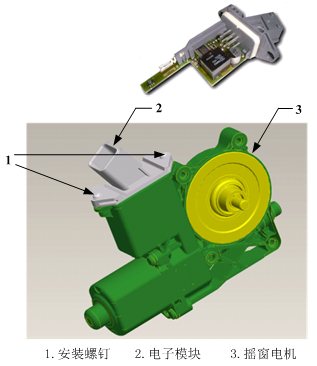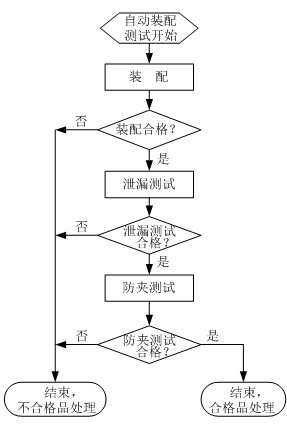Author: Dengzhao Min Kan magnificent Global China Beijing Branch Control Technology Co.,
The electronic and intelligent aspects of modern automotive products are an important direction for its development. With the development of intelligent and complex automotive electronic products, the detection of their production processes also needs to be flexible so as to meet the test requirements for product diversity.
In response to the characteristics and test requirements of automotive window-sanding machines, Pan-China Measurement & Control Co., Ltd. has developed an assembly and testing system for automotive window shakers in conjunction with the "Flexible Test" technology, which has provided a good grasp of the reliability required for assembly and testing of automotive window-sinks. The need for accuracy, adaptability, flexibility, and scalability.
The car window winder The window winder of the car is composed of a window motor and an electronic module. According to different installation positions, it can be divided into a left front door, a left rear door, a right front door, and a right rear door winder. The electronic module of the window shaker can control the motor to rotate in a forward or reverse direction, thereby effectively controlling the rising or falling process of the car window. When the electronic module encounters an obstacle during the ascent of the window, it will react and control the reverse rotation of the motor to make a downward movement so as to avoid injury to the vehicle door or the human. The speed of the reaction is judged by the anti-pinch time, and the clamp is prevented. Time is an important parameter to be tested by this system.

Figure 1 car window machine
The winder assembly testing system described herein is mainly used to assemble the window motor and the electronic module, and to test the sealing performance of the connecting cavity of the motor and the electronic module and the anti-pinch performance of the window washer.
System Test Flow This system is a semi-automated device. Figure 2 shows the assembly test flow in automatic mode. Before starting the automatic mode, you need to manually select the type of window shaker to be tested for assembly. The system is divided into three operating stations, respectively, to achieve the assembly, leakage testing and filling anti-clip test, each station independent operation, the operator manually put the tested parts into the station fixture.

Figure 2 automated assembly test process
The assembly station needs to be manually installed by means of a pneumatic screwdriver. In this station, the installation time can be automatically detected. If the test is unqualified, it is deemed to be a non-conforming part; when leak and anti-pinch test is performed, the user only needs to manually measure the part to be measured. Place the fixture in the station and tighten the clamp to connect the test interface. The test will be performed automatically until the test is completed and the fixture is released (tested) or the touch screen prompts the test to fail. For the latter, the user must Confirm that the pressure device can be released on the touch screen.
In addition to the automatic operation mode, the system provides advanced users with manual and jog operation modes.
Test system composition
1. The hardware is composed to meet the requirements of reliability, flexibility, and extensibility of the assembly and test of the window winder. PLC is used to control the entire system in terms of hardware components. The hardware resources and system components are shown in Figure 3. The system uses Siemens S7-300 series PLC (integrated RS232, Ethernet communication module, 16-bit high-speed DI, 32-bit DI/DO module) as the control core, together with related peripheral monitoring and control equipment and human-machine interaction equipment, including leakage testing. Instrument, anti-pinch test unit, bar code printer, programmable power supply, Siemens touch screen, etc.

Figure 3 Hardware composition of the window-window assembly test system
2. Software implementation The software design of the window-window assembly test system includes two parts: system measurement and control software and human-computer interaction software. The system measurement and control software is designed and developed based on Step7 V5.4. The human-computer interaction software is designed using Winck Flexible.
Among them, the systematic measurement and control software adopts the modularized way in function realization, the particular function is realized by the particular module. The main components are:
This module can shut down the system for shutdown, reset each cylinder and data area, initialize the programming power supply, ILG and wait for the leak tester to be ready;
Alarm light and panel indication control moduleControl system current operating mode, test status and alarm indicator light changes;
User input response moduleDetect the status of each button on the operation panel and touch screen and respond accordingly;
Instrument Control ModuleSystem control of various hardware devices, including cylinders, leak testers, programming power supplies, ILG, anti-pinch test units, and printers;
Installation timeout detection moduleControl screw operation and time-out detection of screw installation;
Automatic operation moduleRealize the automatic operation of system installation, leak test and anti-pinch test;
Manual operation moduleRealize manual operation of system installation, leak test and anti-pinch test;
Jog operation modulePerforms inching operations for system installation, leak testing, and anti-pinch testing.
The human-computer interaction software is designed using WinCC Flexible, WinCC Flexible is a configuration software applied to the touch screen interface design.
The human-computer interaction interface supports Chinese and English bilingual operation. In the interactive use with the touch screen, user's login and management, automatic, manual or jog operation mode switching can be realized.
System Performance and Typical Process Completion Time The auto-window window assembly test system has complete functions, stable and reliable performance, and high test efficiency, and can meet the demand for long-time mass production testing on the window-shaping machine production line.
The system adopts the modular design of fixtures for the diversity of the structure and shape of the window motor, and is suitable for the assembly and testing of a variety of motorized electronic modules of the window washer.
The completion time of the typical process of this system is shown in Table 1:
Table 1 Typical process completion time
Station
Process
The process begins
End of process
Time (seconds)
all
Whole assembly test cycle
Pick up new motors and electronic modules at the installation station
Place the tested pass/fail pieces into blue/red bins
46
Assembly station
assembly
Pick up the motor and electronic module
Assembly completed
15
Sealing test station
Automatic sealing test
Put part to sealing test station
End of tightness test
11
Anti-clamp test station
Automatic filling and anti-clamp test
Place parts to anti-clamp test station
Anti-clip test ends and prints labels
18
summary
In summary, the features of the window-window assembly test system, such as simple operation, high degree of automation, and user-friendly interactive interface, all bring the greatest convenience to the operator. At the same time, the multi-station modular design is also The system improves scalability. At present, the system has been successfully applied in a number of automotive electronics companies.